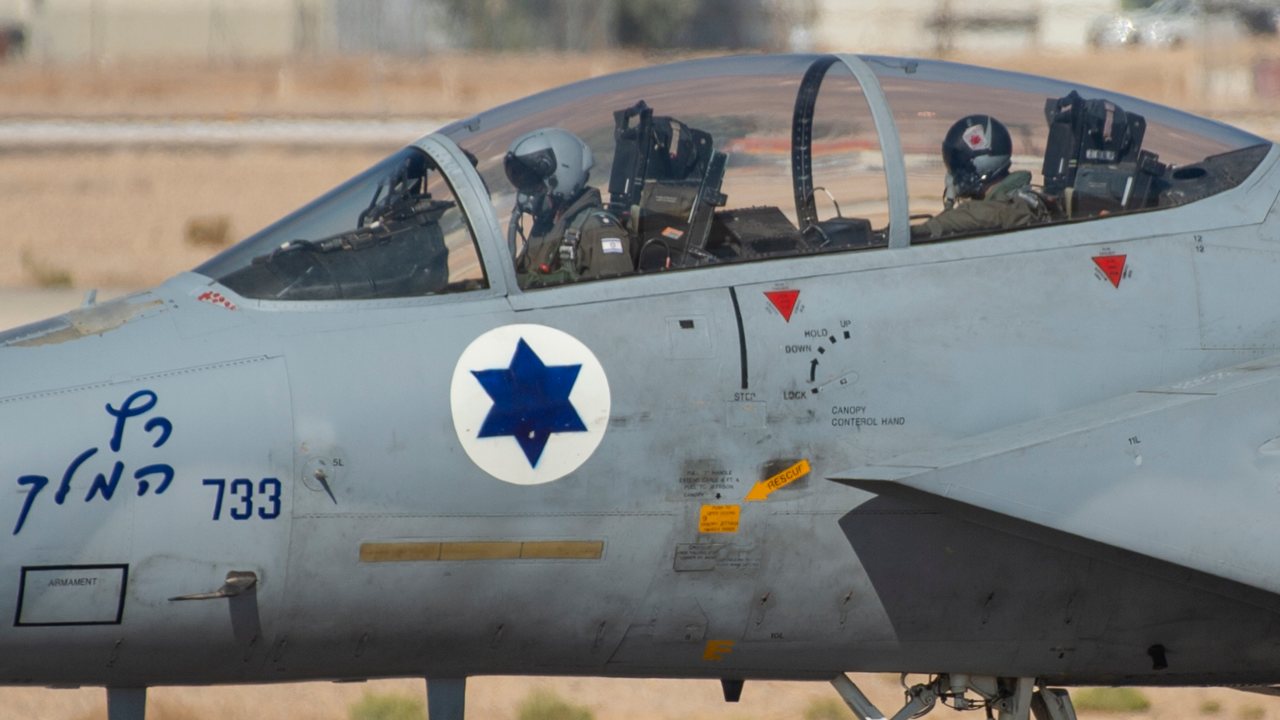We support our Publishers and Content Creators. You can view this story on their website by CLICKING HERE.

Is war between Hezbollah and Israel next? Against the backdrop of the October 7th attacks by the Hamas terrorist organization, Israel became embroiled in its largest invasion of Gaza to date and overall biggest regional conflict against multiple adversaries not seen since the Yom Kippur War.
The fighting in Gaza is intense, with several hundred IDF casualties and half of Hamas’ battalions incapacitated. Civilian casualties have ensued due to the brutality of urban warfare and the population density of the Gaza Strip.
Hamas, an organization armed and funded by the Mullahs of the Islamic Republic, is also supported by a major Iranian Revolutionary Guards Corps (IRGC) affiliate, Hezbollah—the most powerful of all Iran’s proxies. The ongoing fighting between Israel and Hezbollah is raising concerns as both belligerents represent the strongest powers in the region that could make the Middle East explode.
Northern Front
Immediately after the October 7th attacks and Israel’s declaration of war against Hamas, Hezbollah intervened to supplement Hamas, which the Lebanese militant group is allied with.
For the past seven months, Israel and Hezbollah have resorted to low-level fighting with tit-for-tat strikes on one another akin to fighting that has taken place from Syria. Israel has liquidated numerous commanders of Hezbollah, including those belonging to the elite Radwan unit.
Strikes have also occurred against Hamas’ Lebanese branch throughout the winter and the spring as the Gazan militant group has expanded cells in not only the West Bank but also Southern Lebanon, which Hezbollah firmly controls.
Hezbollah’s goal initially was to draw and distract Israeli units to their Southern Lebanese border to give Hamas breathing room, but with Hamas nearly depleted and most of Gaza cleared the Shia militia has now resorted to a more effective yet dangerous strategy.
Growing Hostilities between Hezbollah and Israel
Knowing their anti-tank, drone, and missile attacks have not drawn IDF attention away from Hamas, Hezbollah, in coordination with the IRGC, is leading a campaign to displace Israeli citizens from the north permanently.
Israeli civilians have been displaced from Northern Israel with estimates of 60,000 to 80,000, and the number could rise as Hezbollah’s missile attacks have started major wildfires in the more vegetative north. Simultaneously, over 95,000 Lebanese civilians are also displaced by the fighting.
The displacement of Israelis is a propaganda victory for the Islamic Republic’s ‘axis of resistance’ as Hezbollah has forced Israeli civilians to flee their homes in the north, which is also an aim of Hamas and the IRGC. Due to increased attacks by the militant group, Israel is stepping up operations, which include deep raids on regions in Lebanon that have rarely been targeted, such as Hermel.
In mid-June, Israel targeted Taleb Abdullah, the most senior official in Hezbollah thus far from Israeli raids. In return, Hezbollah struck several IDF outposts, including the Druze town of Hurfeish, that killed one soldier and wounded nearly a dozen.
Both Hezbollah and the IDF are resorting to igniting fires, with the former forcing civilians to flee and the latter using trebuchets to reinforce the border from potential infiltrations, as seen in 2006.
In response to growing tensions with the Shiite militia, Israel’s operations room approved of contingency plans to invade Lebanon and push Hezbollah back beyond the Litani River. It can be assessed that the goal of the IDF operational plans would be to create a demilitarized zone (buffer) where Hezbollah’s anti-tank missiles and mortars would have trouble with accuracy.
Hezbollah’s Geographic Advantage
Hezbollah currently has a contingency in case of an Israeli invasion, which is rigid terrain. In the 2006 War, Israel’s vaunted Merkava tanks faced difficulties in the Lebanese topography, and the IDF faced heavy armor losses.
Using geography to their advantage, Hezbollah, then only having 1,000-2,000 militiamen at the time, was able to fight Israel to a status quo antebellum after a UN-led ceasefire occurred after 30 days.
The war only made the paramilitary organization popular in the region due to being the only force that fought Israel to near equal terms both in 2006 and during the two-decade Israeli occupation of Southern Lebanon.
Combating Hezbollah during the Syrian Civil War and the ongoing clashes in the north, the IDF is using different tactics to not fall into the militia’s trap for now. Using GPS jamming, the Israeli military is confusing Hezbollah’s and Syria’s missile defense—painting ghost targets to fire at while the real air raid reaches its target.
Nevertheless, Hezbollah, so far, is only allocating a small contingent of rockets, anti-tank missiles, mortars, and a light garrison of their overall troop strength. Likewise, the IDF is avoiding widespread air raids and covert operations.
Hezbollah could also continue minimal indirect or direct artillery to continue keeping the fear of internally displaced refugees from returning home and baiting Israel into another incursion, which would continue to diminish their international standing.
The Nightmare Scenario the World Wants to Avoid
Current hostilities are high, but both Israel and Hezbollah know what is at stake if full-scale war were to happen between both. Over the past decade, both combating parties gained experience due to conflicts the past decade and the ongoing war ignited by the October 7th terrorist attacks by Hamas.
Intervening on behalf of Bashar al-Assad’s regime, Hezbollah’s military wing gained more conventional and unconventional military experience and helped turn the tide of the Syrian Civil War. This came at the expense of the group’s popularity, as the region now saw the militia as nothing more than sectarian mercenaries for hire.
Likewise, Israel has gained more urban warfare experience, fighting not only prior wars with Hamas this past decade but also numerous clashes in the West Bank, as seen in the Jenin raids. Israel’s Air Force also enhanced strategic bombings in Iran, Lebanon, and Syria, taking out key IRGC commanders, weapons depots, and air defense radars.
Hezbollah commands many short, medium, and long-range ballistic missiles, estimated to be anywhere between 120,000 to 150,000. The rocket arsenal can reach anywhere in Israel and also much of the Middle East.
The militia also holds a large stock of anti-ship missiles and suicide drones, both of which can affect Israeli and allied navies, along with military outposts and the port of Haifa—especially if Hezbollah manages to overwhelm Israeli air defenses.
Hezbollah, with its vast arsenal, can potentially launch upwards of 5,000 to 10,000 rockets a day, not including its growing drone capabilities and troop strength—estimated to be 25,000 full-time fighter with 50,000 in reserves.
Because of such a threat, Israel would be compelled to conduct a major ‘shock and awe’ campaign, but this would lead to major Lebanese civilian losses, which Israel can ill-afford with international reputation dissipating. Nasrallah May attempt to bait Israel into such a trap akin to Yahya Sinwar’s methods in Gaza.
In lieu of being baited, the IDF would first prioritize the most prominent launching sites of rockets—particularly the medium and long-range variants that would reach Israel’s most sensitive economic, scientific, and military areas. Then they may conduct a limited invasion to push Hezbollah beyond the Litani as a full incursion into Lebanon, which would lead to greater destruction and would only turn opinions of Israel far more negative amongst Lebanese, as seen in the prolonged Israeli occupation in the Southern Lebanon Conflict.
A New Israel-Hezbollah War Will Go Regional
The United States and France are preparing contingencies in case of war—especially as Israel is a major American ally and France still holds close ties with the Lebanese nation dating back to the colonial era. CNN recently reported that the US would fully back Israel if it comes intertwined with a full-scale war with Lebanon. Still, the Biden Administration fears Iran may be compelled to intervene.
Hezbollah, a bread basket of the Mullahs, is a major thorn keeping Israel away from focusing resources against the Islamic Republic. Because of this, Iran may intervene and send tens of thousands of foreign militia fighters and IRGC military advisers to Lebanon to reinforce Nasrallah’s militia.
America could potentially send more naval assets to the region as the Aegis missile system played a significant role in shooting down numerous Houthi and Iranian missiles and drones in the Red Sea and over Israeli airspace. It can be expected America will also shoot down numerous Hezbollah projectiles with its missile defense systems due to fears that Israeli air defense could be overwhelmed.
The Mediterranean countries of Cyprus, Turkey, and Greece may also be intertwined in a broader Israeli-Hezbollah war. Recently, Hassan Nasrallah threatened Cyprus with missile attacks if the government were to provide support to Israel, such as base usage for air raids.
The threats from Hezbollah on Cyprus are unfounded as Israel is in closer proximity to Lebanon and constantly uses their airspace to launch sorties due to Hezbollah not having modernized air defense. The threats towards Cyprus also can draw in Greece and Turkey, as Athens holds a mutual defense pact with Nicosia, and Ankara has 43,000 troops in the Turkish-occupied regions of the Mediterranean island nation.
British sovereign bases in Cyprus, such as RAF Akrotiri and Dhekelia, could also come under threat by Hezbollah, and the bases, which cooperate with the US military, would draw the UK and America into a more direct combat role if attacked.
How Will it End?
The United States, France, the United Nations, and other regional mediators are conducting ongoing negotiations to mitigate a wider crisis. A war would guarantee another mass refugee crisis, especially as Lebanon, per capita, holds some of the biggest refugee populations today, which could be exacerbated if a ground operation ensues.
Though the US has reportedly guaranteed support for Israel, the Pentagon will expect a comprehensive day-after plan from the Israeli cabinet of Netanyahu. PM Netanyahu has come under scrutiny by America, the opposition, and even high-ranking figures in his military for not having a postwar plan in Gaza, which could allow Hamas to emerge again.
While the Israeli military excels in modern warfare, the IDF also falters in prolonged conflicts, which it could face in Lebanon. During the Lebanese Civil War, the Israeli army was able to incapacitate the Syrian Air Force and push the PLO into a settlement to leave Lebanon for Tunisia—but willing to stay longer than expected, Israel fell into a major trap.
The prolonged occupation of Southern Lebanon only turned local opinions against Israel, and due to the powder keg of a lack of a postwar plan from PLO expulsion, the Mullahs of Iran were able to create Hezbollah from the ashes. The occupation also shows Israel and its Southern Lebanese Army allies could not stay long or make a true buffer zone as casualties mounted and international pressure forced an IDF withdrawal.
To enact a buffer zone for civilians to feel safe, Israel would need guarantees from not only Western nations like America and France but also regional cooperation with the UAE, Saudi Arabia, and the Lebanese government and army. This would be as hard as the latter two, which still do not have peace deals with Israel.
For now, Israel will have to remain patient, finish the war in Gaza, amass substantial logistics, and wait out ongoing talks before making a drastic move. However, if Hezbollah makes a preemptive strike, there would be near guarantees of direct American intervention, which Nasrallah wants to avoid.
Overall, the border clashes between Israel and Hezbollah come down to which side blinks first. Both are aware a full-scale war would significantly damage both Lebanon and Israel. Still, nevertheless, Lebanese civilians in the south and Israeli civilians in the north will never feel safe again returning home until either party works to enact a buffer zone. Now, time will tell.
About the Author: Julian McBride
Julian McBride, a former U.S. Marine, is a forensic anthropologist and independent journalist born in New York. He reports and documents the plight of people around the world who are affected by conflicts, rogue geopolitics, and war, and also tells the stories of war victims whose voices are never heard. Julian is the founder and director of the Reflections of War Initiative (ROW), an anthropological NGO which aims to tell the stories of the victims of war through art therapy. As a former Marine, he uses this technique not only to help heal PTSD but also to share people’s stories through art, which conveys “the message of the brutality of war better than most news organizations.”

 Conservative
Conservative  Search
Search Trending
Trending Current News
Current News 





